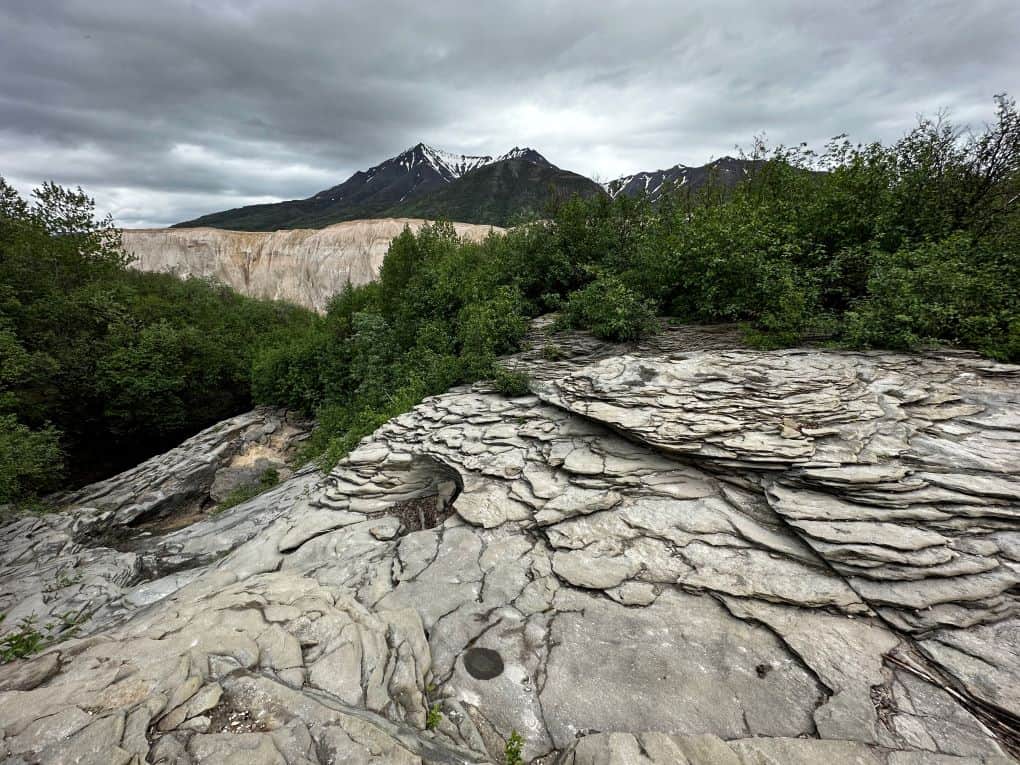Katmai National Park and Preserve in Alaska is home to a place that can be found nowhere else – the mysterious Valley of Ten Thousand Smokes. There is nothing quite like stepping into a world of geological wonders in this hidden gem shaped by the 1912 eruption of Novarupta volcano. Although we could not do this tour, it was awe-inspiring, listening to Alaina and Katie talk about their “out of this world” experience. It is hard to fathom the tons of ash that erupted from Novarupta.
This post may contain affiliate links, meaning if you purchase something through one of these links, we may earn a small commission at no extra cost to you! Read the full disclosure policy here.
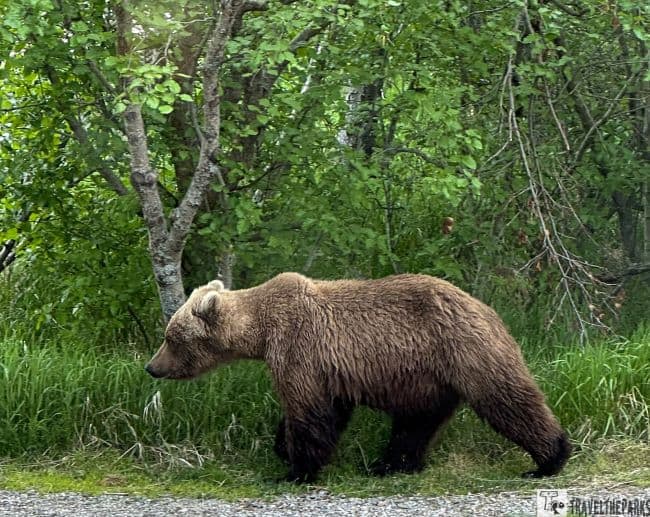
In order to take the tour from Brooks Camp, a fee is charged. Reservations are required preferably in advance, as spots are limited. It does sell out quickly during peak times. The bus departs Brooks Lodge at 9:00 am for the 8-7 hour tour of the Valley of Ten Thousand Smokes (check the official park site). The 2-hour ride out is on a muddy gravel road. It can be bumpy and rough. The bus returns at 4:00 pm.

Along the 23-mile drive out, the bus stops at two points. The first stop, 30 minutes into the drive, has pit toilets. From here, Alaina had a panoramic view of the mountain range that rings the scenic valley. A second stop is another 30 minutes later for a brief time. Along the drive, the bus fords 3 or 4 creeks depending on the season. Brown bears, lynx, moose, and even the occasional wolf can be seen on route to the valley.

Table of Contents
Unveiling the Valley of Ten Thousand Smokes Origins
As the bus travels the open single lane road, the park ranger narrates the history of the valley. This land was the ancestral homelands of the Alutiit-Sugpiat (Aleut) people. However, over a century ago, a powerful volcanic eruption shook the region, giving this valley its unique name. An eruption like no other occurred in June 1912, when the earth rumbled and erupted. Volcano Novarupta spewed 4 cubic miles of molten lava, ash, and 2.6 cubic miles of pyroclastic flows across the surrounding landscape. The volcanic ash cloud reached heights of up to 20 miles. It was 30x greater than Mt. St. Helens. The following years, 1913 and 1914, are often referred to as the “Year Without a Summer” because of the global cooling caused by the eruption.

The eruption caused Mount Katmai’s summit caved in, by draining the magma chamber thus forming a caldera. It slowly filled with water, creating Katmai Crater lake. It is approximately 2,000 feet deep. What remains is a landscape of rugged canyons, towering ash dunes, and ethereal volcanic spires formed as the ash cooled and solidified. Because of this eruption, President Woodrow Wilson declared the valley as Katmai National Monument in 1918. Steam still rises today from the 200 foot collapsed dome of Novarupta.

Robert F. Griggs discovered and explored the valley in 1916. Griggs led a National Geographic Society expedition to the Katmai region of Alaska to learn more about the effects of the eruption of the Novarupta volcano. When the expedition arrived, they found a desolate, barren landscape. Griggs’s work continues to impact the fields of geology, glaciology, and environmental conservation. His contributions to the understanding of volcanic landscapes and their aftermaths remain influential in these fields.

Honoring a Legacy: Robert F Briggs Visitor Center
Once you arrive at the Robert F. Griggs Visitor Center, the ranger provides a light lunch (extra cost, so bring your own) with warm drinks for visitors. Alaina and Katie described visiting the Valley is like stepping into a surreal dreamscape. Inside are exhibits explaining the flora and fauna of the area. There are also historical displays and photographs. After the lunch, the optional hike to Ukak falls or you can enjoy the views of the valley. For those less adventurous, the walk to the Three Forks Overlook provides a grand view of the vast expanse of ash stretching as far as the eye can see. Quite otherworldly.

Exploring the Majestic Ukak Trail in the Valley of Ten Thousand Smokes
This trail starts near the Robert F. Griggs Visitor Center and takes you through the Valley of Ten Thousand Smokes and the surrounding volcanic landscape. The moderately difficult trail is 3.5 miles round-trip with a 1000-foot elevation change. Every step brings you closer to the heart of the Valley of Ten Thousand Smokes, where the remnants of the volcanic eruption still linger, leaving behind a stark, yet captivating landscape.

After a light lunch, a ranger led hike explores the remarkable remnants of the Novarupta volcanic eruption. The Windy Creek Overlook and Ukak Falls trail begins to the left of the visitor center, slowly descending through the underbrush. Approximately 3/4-mile mark the trail forks. The 1/2 mile fork to the right leads to the Convergence Overlook. Surrounded by lush vegetation, at the end there are panoramic vistas where the valley’s three main rivers, Knife Creek, the River Lethe, and Windy Creek converge, forming the Ukak River. The Ukak River flows to Naknek Lake (Iliuk Arm).

Witnessing the Once Smoking Fumaroles in the Valley of Ten Thousand Smokes
The Valley of Ten Thousand Smokes still hides a volcanic landscape beneath its surface. Extinct fumaroles, which once emitted steam and volcanic gases, can be seen as you hike. It was a reminder to Alaina and Katie that nature is constantly reshaping the Earth as it shapes and reshapes these once smoking vents.
The Ukak River flows gently through the valley, cutting through ash deposits and rugged terrain. The rugged volcanic remnants that surround you contrast with the turbulent river meandering through the canyons. Despite its isolation, the Valley remains an unspoiled sanctuary for nature as it regenerates.
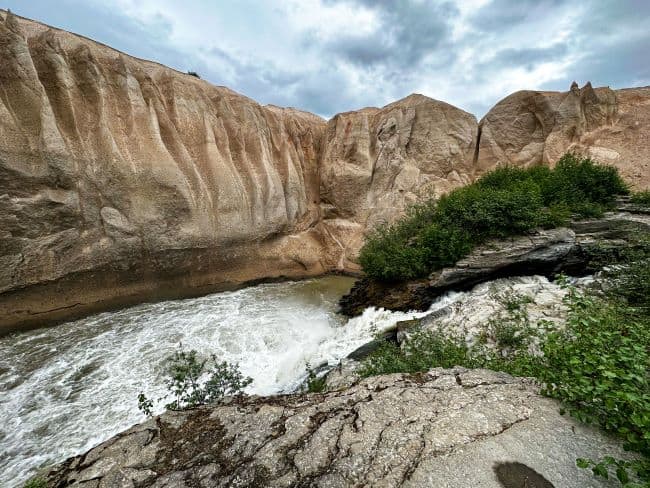
Nature’s Masterpiece: Ukak Falls
The geological formations abound along the winding trails. It was hard to miss the layers of volcanic ash on the rugged walls of Ukak Canyon, which reveal a cataclysmic past. Further into the canyon, they encountered remnant “pyroclastic flows,” which resemble petrified rivers of ash frozen in time.
The immense ash deposit that lined the valley astounded Alaina and Katie. The ranger pointed to evidence of ash flows, pyroclastic deposits, and pumice spires. These fascinating features bear witness to the volcanic forces that shaped this remarkable landscape over a century ago. It’s a living testament to the ever-changing nature of our planet.

Alaina said that embarking on the Ukak Trail in the Valley of Ten Thousand Smokes was a mesmerizing journey into the heart of one of Alaska’s most secluded landscapes. She said, “the power of nature and the incredible beauty it has created will humble you.”

Tips for Explorers: Preparing to Hike Valley of Ten Thousand Smokes
- Plan Ahead: The Valley of Ten Thousand Smokes is a remote location, accessible only by bush plane or the bus tour. Ensure you make arrangements for transportation and accommodations in advance.
- Be Prepared-Pack essentials: Pack essential supplies, including sturdy hiking boots, appropriate clothing layers, sunscreen, insect repellent, binoculars and plenty of water. The weather can be unpredictable, so come prepared for changing conditions.
- Practice Leave No Trace: Respect the environment and adhere to Leave No Trace principles. Pack out all trash and minimize your impact on this delicate ecosystem.
- Safety precautions: If you plan to hike the road, be bear-aware and carry bear spray (can be purchased at the Brooks Trading Post). Make noise while hiking to alert bears of your presence.
- Capture Memories: Don’t forget to bring your camera or smartphone to document the stunning landscapes and unique features of the Valley. The visual splendor is something you’ll want to relive and share with others.
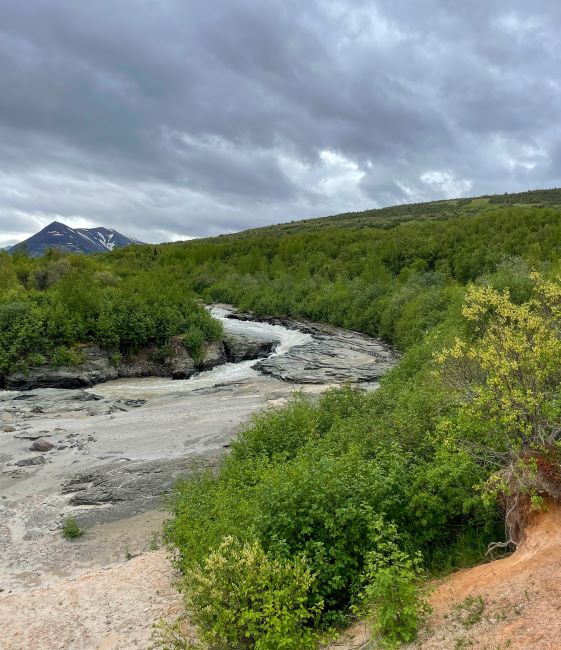
Additional Hiking Trails in the Valley of Ten Thousand Smokes
- The Baked Mountain Trail: This trail begins at the Valley of Ten Thousand Smokes Visitor Center and takes you up Baked Mountain. The trail over the pumice laced flats displays panoramic views of the valley and volcanic ash deposits. It is approximately 8 miles round trip and is rated as moderately difficult. A trail from Baked mountain lead to the still smoking Novarupta dome. Note: Baked Mountain huts are uninhabitable due to storm damage.
- Other trails to destinations such as Knife Creek Glaciers, Katmai Pass to the Mt. Katmai caldera or the Mageik Lakes area (12-miles). Inquire at the visitor center for trail conditions.
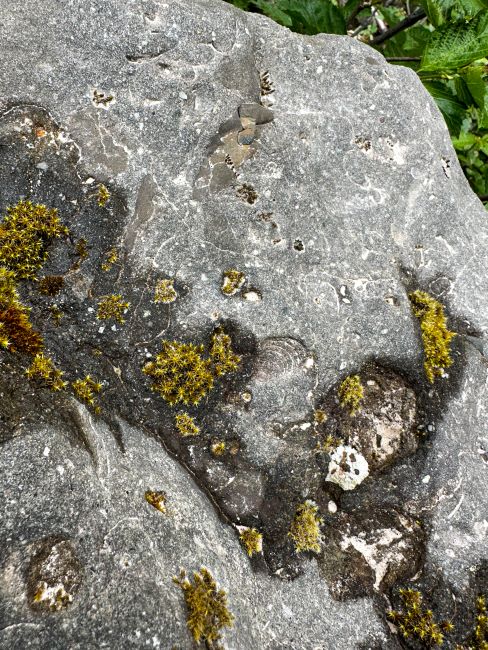
Final Thoughts: Discovery Tour of the Mysterious Valley of Ten Thousand Smokes in Katmai
Special thanks to Alaina and Katie for sharing their adventure and their photographs. The Valley of Ten Thousand Smokes stands as a testament to the raw power of nature and the resilience of life. Exploring this geological wonderland is a journey into the depths of Earth’s history, where every step unravels the secrets of a cataclysmic past.
Have you had the chance to see the Valley of Ten Thousand Smokes? If so, share in the comments your experience. We would love to know your experience.

